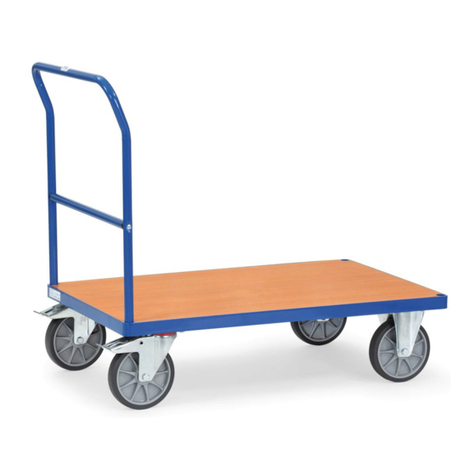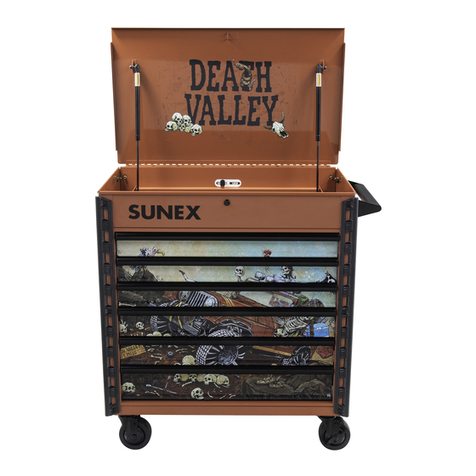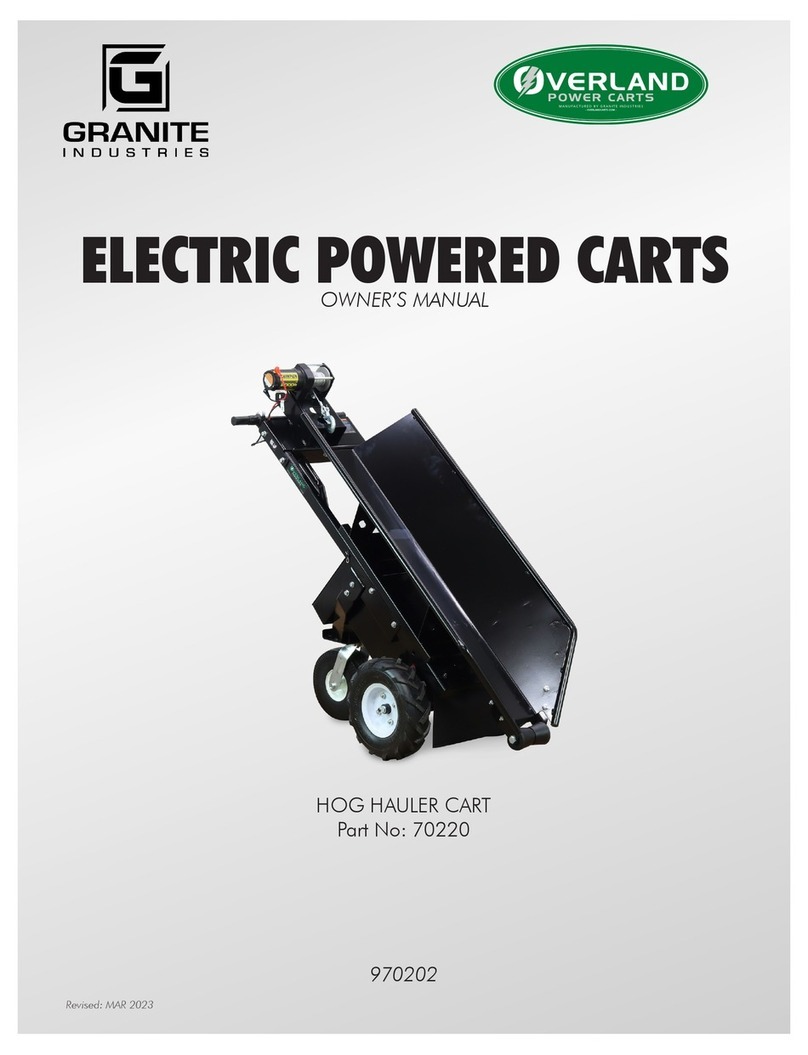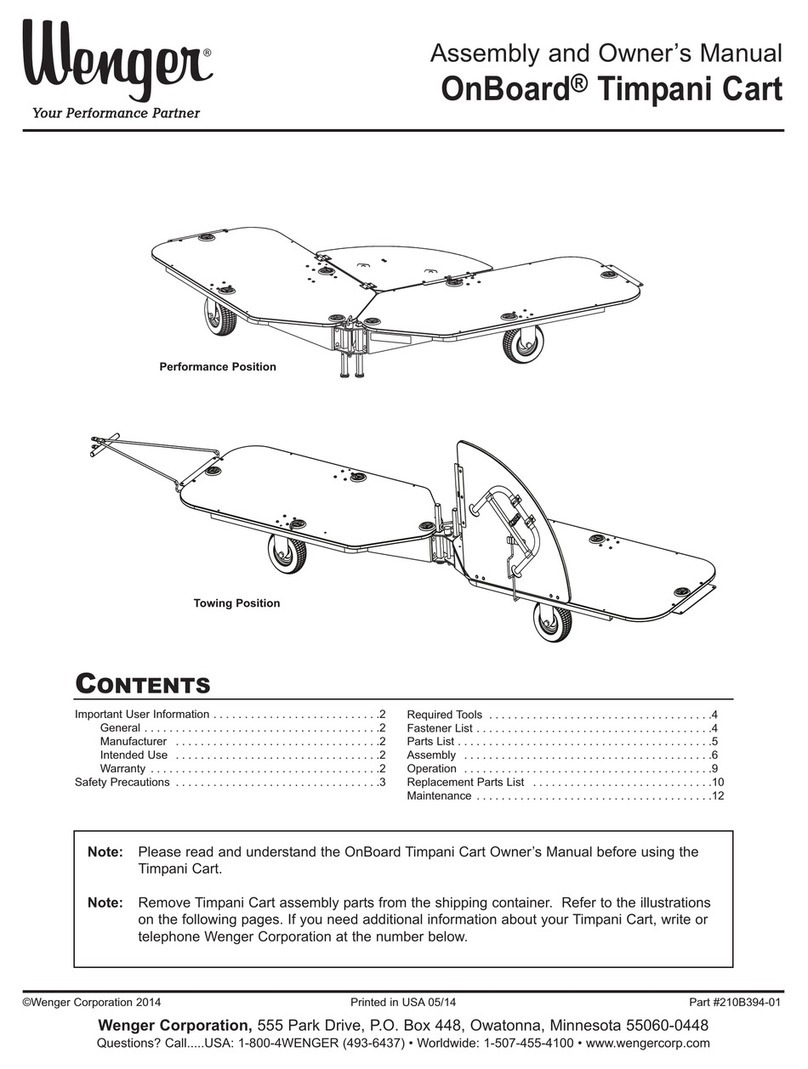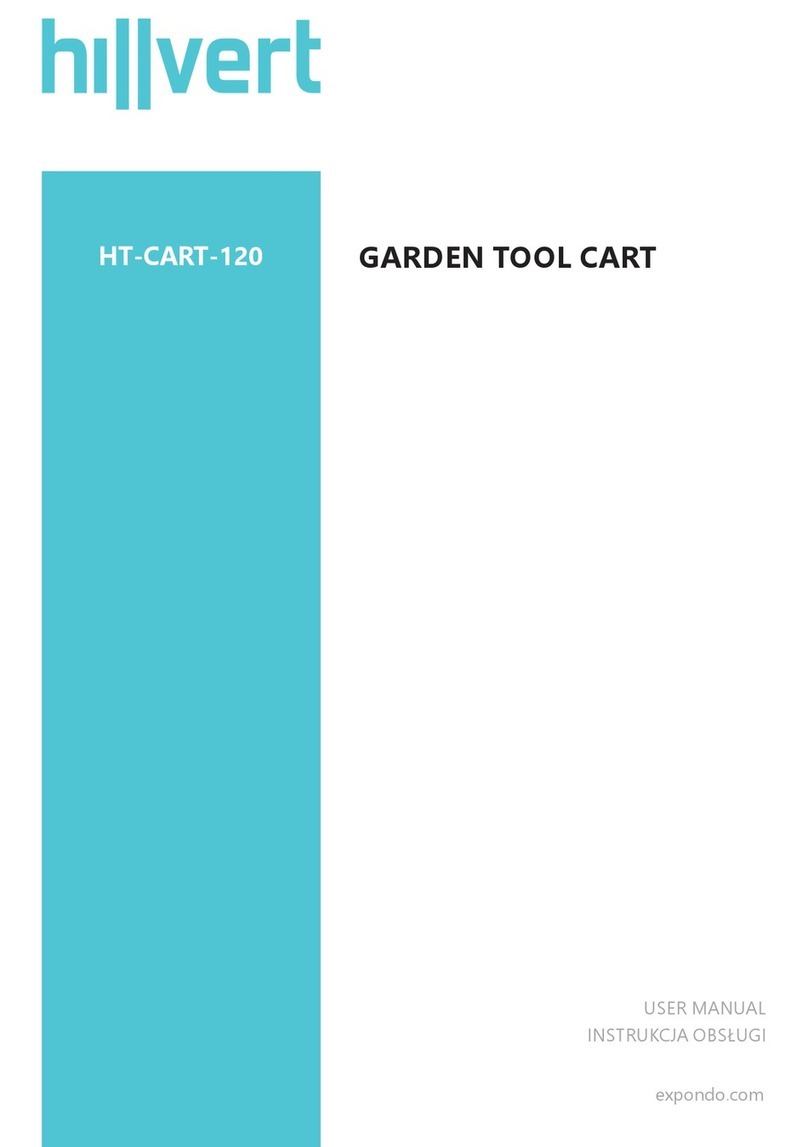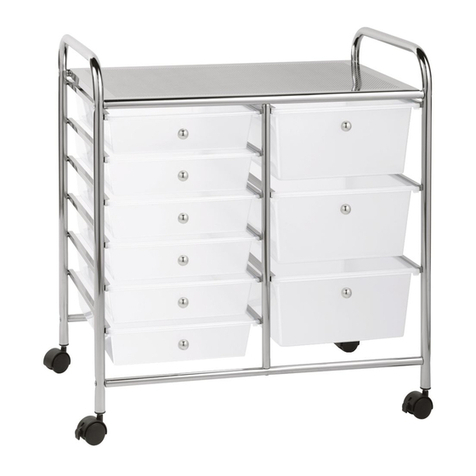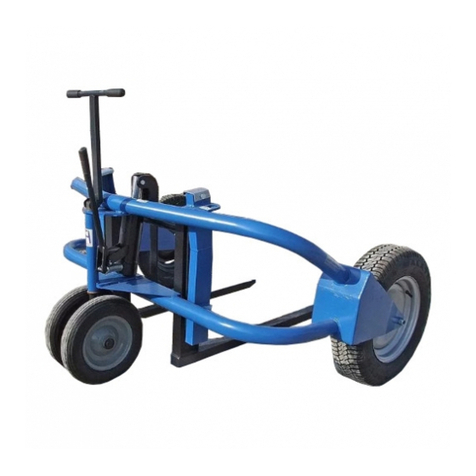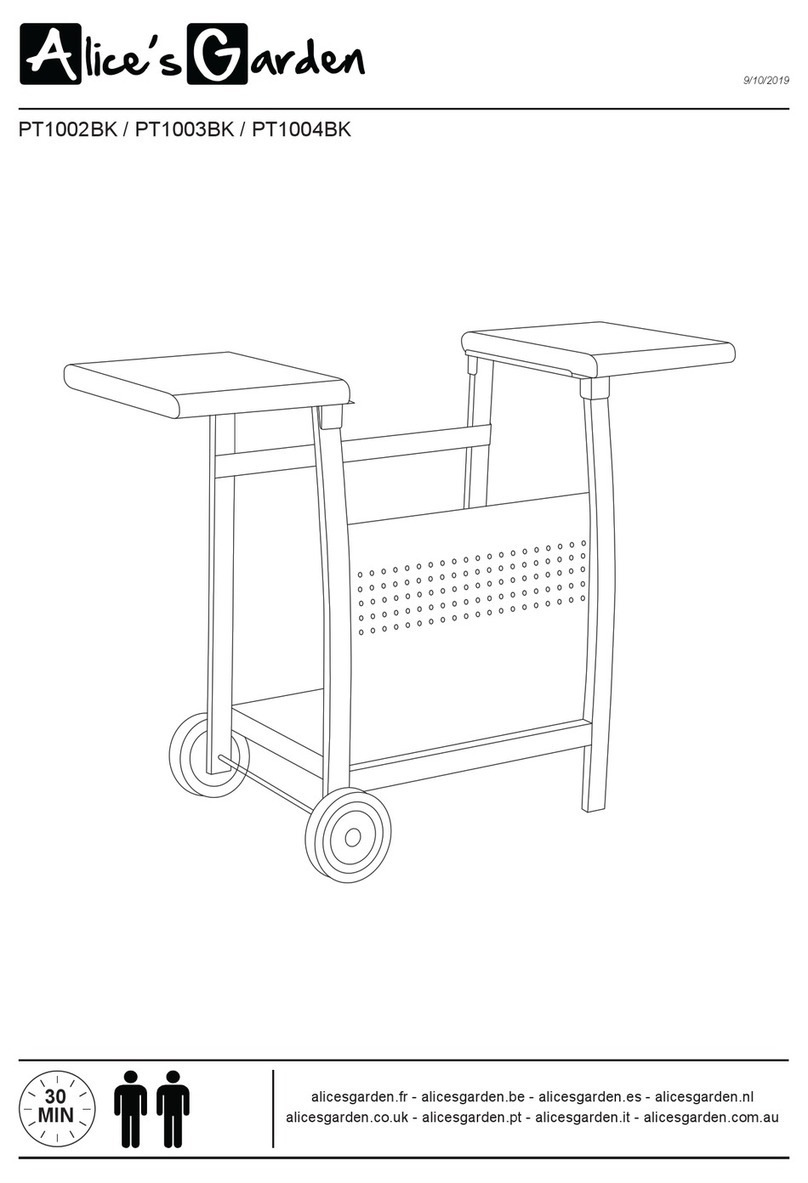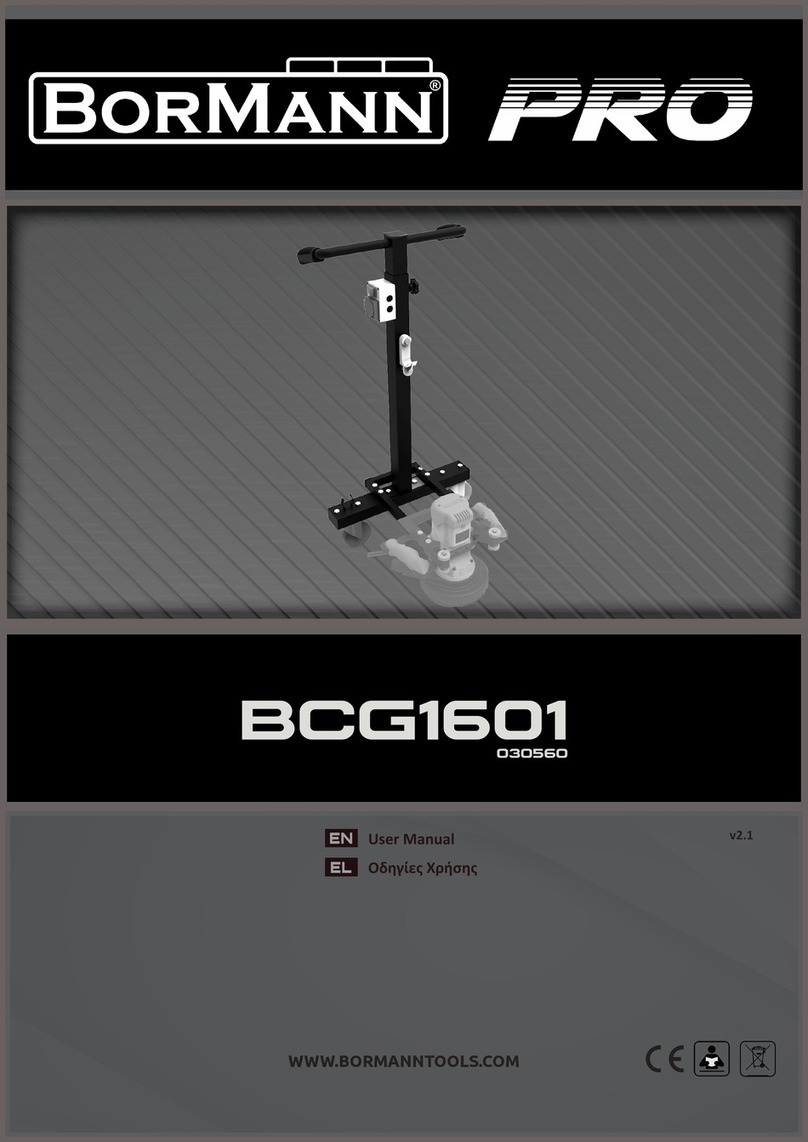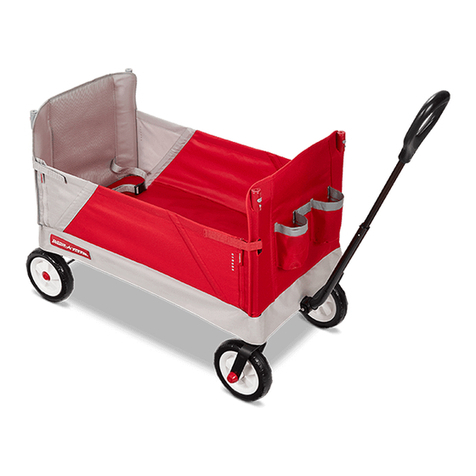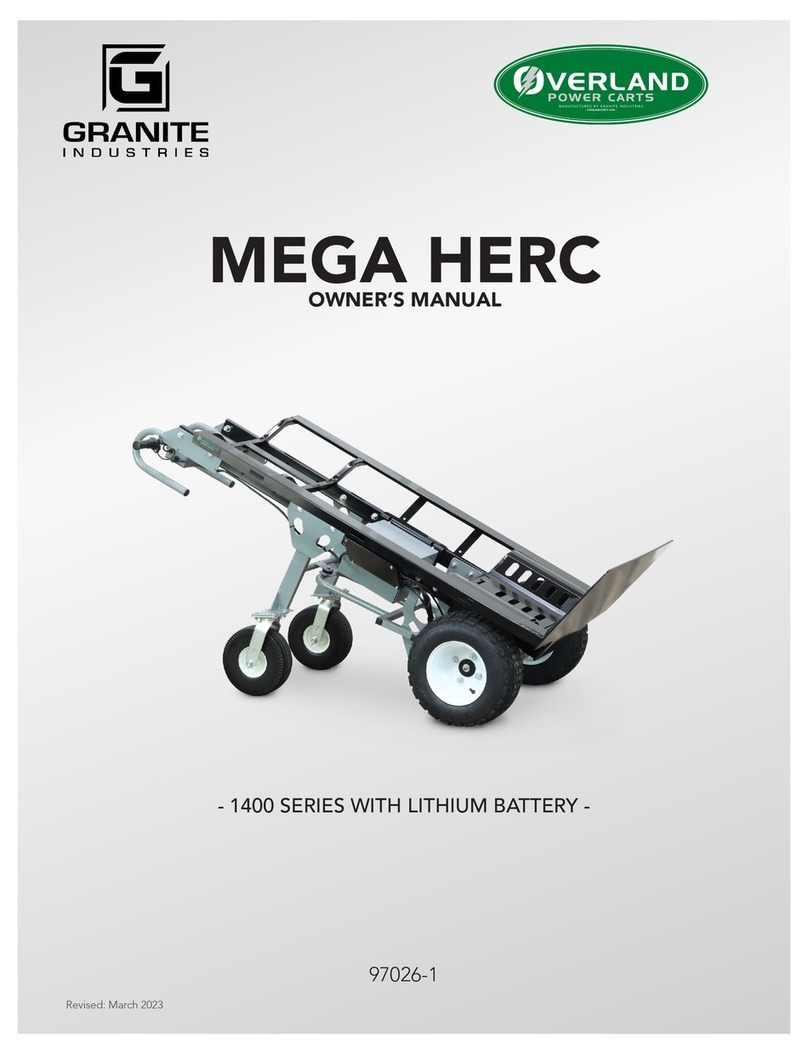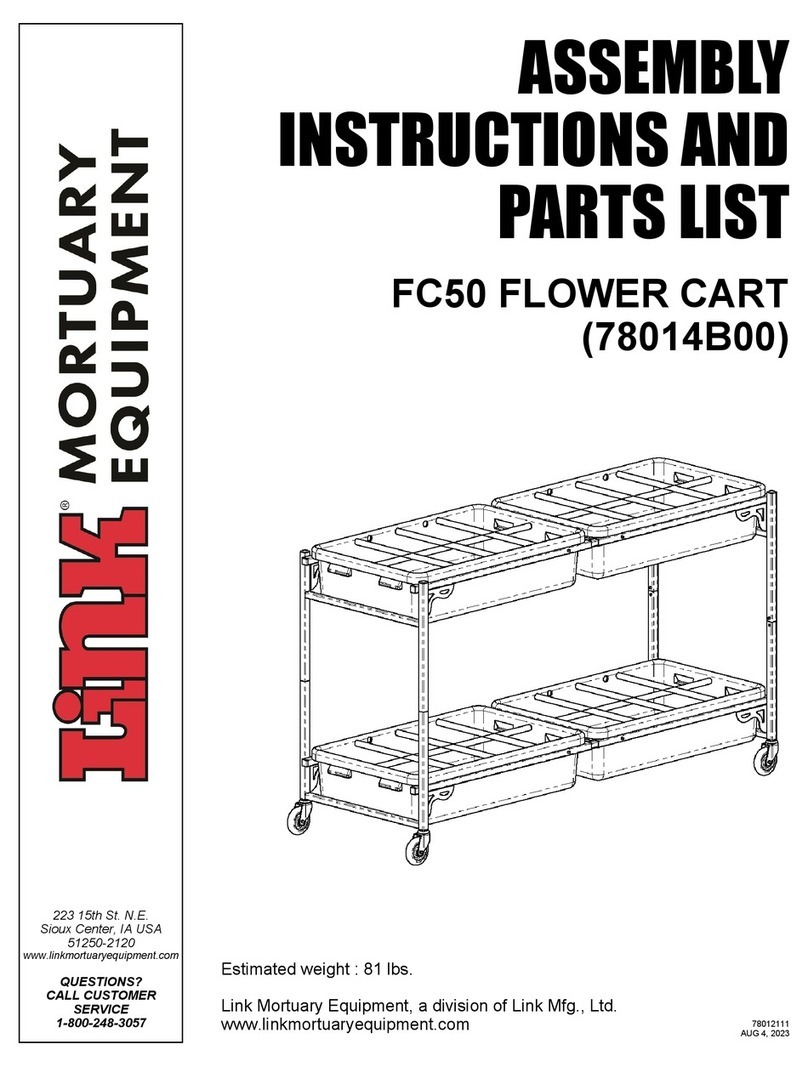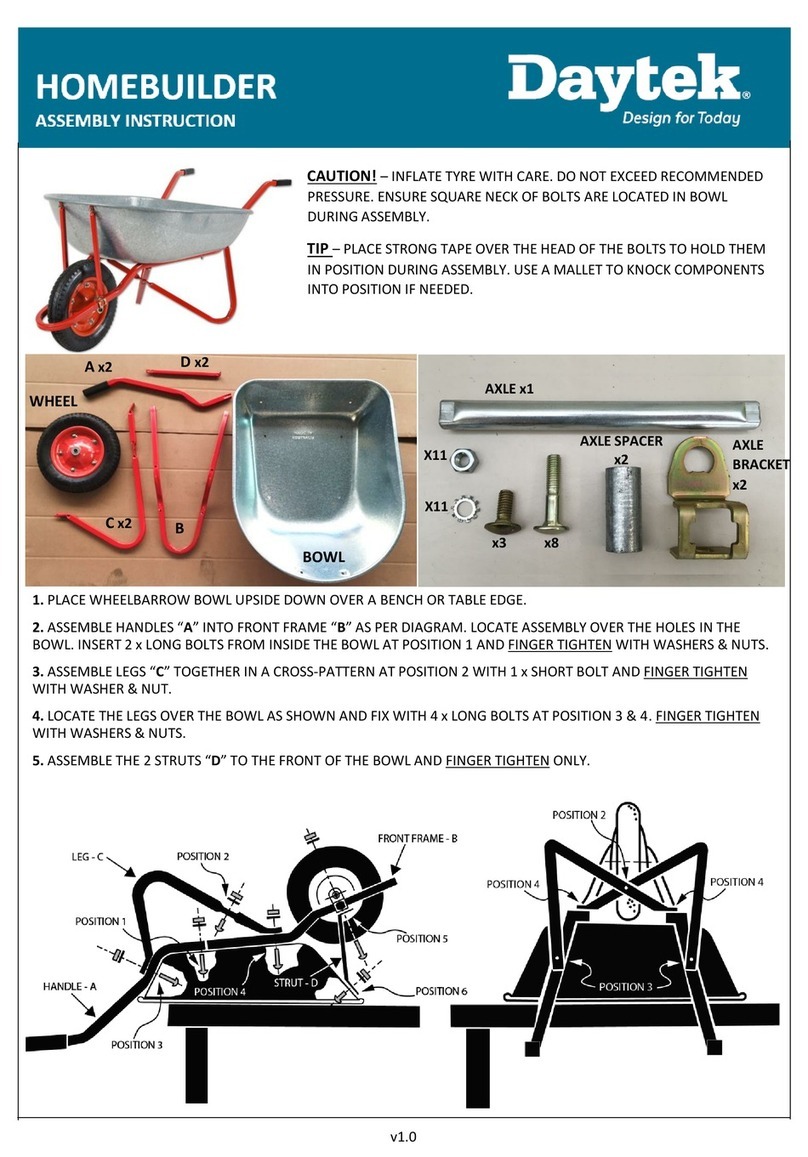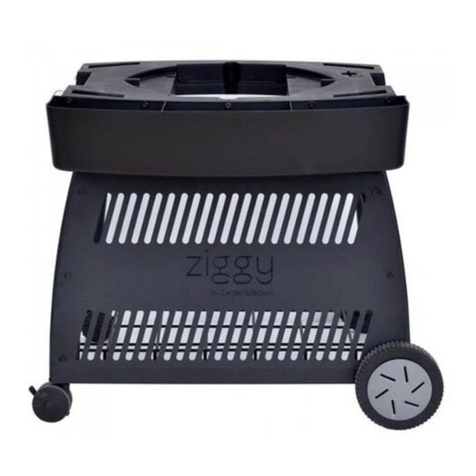fetra 3191 User manual

(DE) – Betriebsanleitung
Materialständer und Rollenbock
(EN) – Operation manual
Mobile tilting stands and roller support
(FR) – Mode d´emploi
Pupitres d´atelier et trépied roulant
(NL) – Gebruikshandleiding
Materiaalstandaard en rolbok
3191
3290/3291
Transportmiddelen

2
Transportgeräte
Betriebsanleitung
Ausgabe 04/2019
Rollenbock 3191
Materialständer 3290 und 3291
(Originalbetriebsanleitung)
Best-
Nr.
Tragkraft
kg
Rad-Ø
mm
Ladeäche
L x B mm
Höhenverstellbar
von – bis mm
Eigengewicht
kg
Material-
ständer
3290 150 75 510 x 410 510 – 700 23
3291 150 75 510 x 410 720 – 1070 26
Rollenbock 3191 150 75 – 780 –1130 21

3
Transportgeräte
Wichtige Hinweise
Diese Betriebsanleitung macht Sie mit den Eigenschaften des Gerätes vertraut.
Sie muss vor dem Einsatz des Gerätes gelesen werden, um Schäden und Unfälle
durch unsachgemäße Nutzung des Gerätes zu vermeiden.
Bitte beachten Sie die Hinweise zur Pege und Wartung. Sie sichern damit die
ständige Einsatzbereitschaft des Gerätes, verlängern
die Lebensdauer und vermeiden teure Ausfallzeiten.
A c h t u n g !
• Vor jeder Inbetriebnahme das Gerät auf Betriebssicherheit und Funktionsfä-
higkeit überprüfen!
• Jeden neuen Bediener anhand der Betriebsanleitung einweisen!
Alle in diesem Text enthaltenen Informationen basieren auf den zum Zeitpunkt
der Drucklegung verfügbaren Daten. Der Hersteller behält sich das Recht vor,
die eigenen Produkte jederzeit und ohne Vorankündigung zu ändern, ohne dass
sich daraus Haftungsansprüche ergeben. Deshalb bitten wir Sie, stets zu prüfen,
ob eventuell eine neue Version vorliegt.

4
Transportgeräte
Allgemeine Anforderung
Der Rollenbock sowie der Materialständer müssen in Übereinstimmung mit
unseren Angaben verwendet, instandgehalten und repariert werden.
Diese dürfen nicht verändert oder mit Anbaugeräten ausgerüstet werden, ohne
dass sich eine sachkundige Person davon vergewissert hat, dass der Rollenbock
oder Materialständer immer noch sicher ist.
Bestimmungsgemäße Verwendung
• Der Rollenbock dient als höhenverstellbare Beistelleinheit zur Unterstützung
von Langmaterialien an Maschinen wie Sägen, Pressen, Bohrmaschinen usw.
und an Arbeitsplätzen im innerbetrieblichen Bereich.
• Der Materialständer dient als höhenverstellbare Beistelleinheit für Kästen,
Drahtkörbe usw. an Maschinen und Arbeitsplätzen im innerbetrieblichen Be-
reich.
• Der zweckwidrige Einsatz des Gerätes ist unzulässig.
• Der Rollenbock und der Materialständer müssen gemäß den Angaben in
dieser Betriebsanleitung verwendet, gewartet und repariert werden.
• Der abweichende Einsatz des Gerätes ist unzulässig und
kann zu Personen- oder Sachschäden führen.
• Der Rollenbock und der Materialständer dürfen nicht in feuer-
gefährlichen, explosionsgefährdeten, Korrosion verursachenden
oder stark staubhaltigen Umgebungen betrieben werden.
• Es ist eine Umgebungsbeleuchtung von mindestens 50 Lux zum Betrieb
des Gerätes erforderlich.

5
Transportgeräte
• Die Betriebstemperatur darf zwischen -10°C bis +40°C betragen.
• Die Bodenverhältnisse müssen rutschhemmend, fest, eben und frei von Lö-
chern und Hindernissen sein.
• Die auf dem Typenschild angegebene Tragkraft darf nicht überschritten wer-
den.
• Die einseitige Aufnahme von Lasten ist zu vermeiden.
• Es ist vom Betreiber sicher zu stellen, dass der Rollenbock bzw. der Material-
ständer nur bestimmungsgemäß verwendet wird und Gefahren für Gesund-
heit und Leben des Nutzers oder weiterer Personen vermieden werden.
• Der Bediener ist während der Nutzungszeit für den Rollenbock bzw.
den Materialständer verantwortlich. Der Bediener muss sich grundsätz-
lich vom ordnungsgemäßen Zustand der Lasten überzeugen. Es dür-
fen ausschließlich sicher aufgenommene Lasten bewegt werden.
• Beim Abstellen des Rollenbocks beziehungsweise des Materialständers
muss dieser grundsätzlich gegen Wegrollen gesichert werden.
Bedienung
1
23
4
5
6
7
3
4
5

6
Transportgeräte
Vor jeder Auf- oder Abwärtsbewegung der Auagerolle (1) oder des Tisches (6)
muss die Klemmschraube (3) gelöst werden.
Das Anheben der Auagerolle (1) bzw. des Tisches (6) erfolgt, indem die
Auagerolle oder der Tisch ohne Last nach oben gezogen wird.
Es ist nicht notwendig den Hebel für das Senkventil (4) dabei zu betätigen.
Ist die gewünschte Stützhöhe erreicht, muss die Klemmschraube (3) wieder bis
zum Anschlag angezogen werden.
Hierdurch wird unbeabsichtigtes Absenken der Auagerolle bzw. des Tisches
verhindert.
Das Absenken der Auagerolle oder des Tisches muss ebenfalls unbelastet
erfolgen.
Lösen Sie dazu die Klemmschraube (3) und betätigen Sie das Senkventil (4) bis
die gewünschte Stützhöhe erreicht ist.
Im unteren Bereich muss die Auagerolle (1) oder der Tisch (6) zum
vollständigen Absenken eventuell mit leichtem Druck durch eine Handäche
belastet werden.
Die Auagerolle des Rollenbocks ist mit seitlichen Schwerkraftanschlägen
(2) ausgestattet, die einem Herunterrutschen von schmalem Ladegut
entgegenwirken. Bei breiterem Ladegut, welches über die seitlichen Anschläge
hinausragt, schwenken Sie die Anschläge um 90° aus dem Auagebereich
heraus.
Zum Neigen des Tisches des Materialständers lösen Sie den Federriegel (7)
unterhalb der Plattform (6) durch eine 180°-Drehung und rasten den Bolzen in
einer anderen, durch die Rasterlochung vorgegebene Tischposition wieder ein.
Achten Sie darauf, dass der Bolzen des Federriegels immer korrekt in der
Lochung einrastet.

7
Transportgeräte
Wir empfehlen grundsätzlich das Tragen von Sicherheitsschuhen und
Arbeitsschutzhandschuhen beim Arbeiten mit dem Materialständer oder
Rollenbock.
Sicherheitshinweise
Die Beladung und Nutzung des Rollenbocks bzw. des Materialständers darf nur
mit angezogenen Radfeststellern (5) an den Lenkrollen erfolgen.
Die Arbeits- bzw. Stützhöhe darf nur ohne Belastung verstellt werden.
Maximal Tragkraft von 150 kg bei der Beladung beachten!
Positionieren Sie das Ladegut immer mittig auf der Auagerolle bzw. der
Tischplattform.
Gefahren bei der Verwendung – Restrisiken
• Es besteht die Gefahr, dass das Ladegut durch Anstoßen oder Gefäl-
le unbeabsichtigt von der Auagerolle rollt bzw. vom Tisch rutscht.
• Des Weiteren besteht die Gefahr, dass beim Betrieb des Rol-
lenbocks mit abgesenkten Schwerkraftanschlägen das Lade-
gut seitlich von der Auagerolle abrutscht oder abrollt.
• Eine weitere Gefahr besteht beim Verschieben des Ladeguts, wenn das
Ende des Ladeguts den Kontakt zum Rollenbock verliert und dadurch
herunterfallen oder sich absenken kann. Stellen Sie stets eine Zwei-
punktauage des Ladeguts mit ausreichend großer Stützweite sicher.

8
Transportgeräte
• Der Bediener hat in seiner Verantwortung als Maschinenführer darauf zu ach-
ten, dass sich keine unbefugten Personen im Arbeitsbereich des Rollenbocks
oder des Materialständers aufhalten und, dass ihm die Benutzung des Rollen-
bocks oder des Materialständers keinesfalls außer Kontrolle geraten kann.
Verbotene Verwendung
• Der Rollenbock und der Materialständer dürfen nicht auf Gefällestrecken oder
abschüssigen Böden verwendet werden.
• Der Rollenbock und der Materialständer dürfen nicht in unzureichend
beleuchteten Bereichen verwendet werden.
• Der Rollenbock und der Materialständer dürfen nicht unter Last
höhenverstellt werden.
• Der Rollenbock und der Materialständer dürfen für Anwendungen, bei denen
Gefahr einer Überschreitung der Tragfähigkeit besteht, nicht verwendet
werden.
• Der Rollenbock und der Materialständer dürfen für Anwendungen, bei denen
Gefahr einer unbeabsichtigten Bewegung besteht, nicht verwendet werden.
• Der Rollenbock und der Materialständer dürfen nicht im direkten Kontakt
mit Lebensmitteln eingesetzt werden.
• Der Rollenbock und der Materialständer dürfen nicht in explosionsfähiger
Atmosphäre eingesetzt werden.
• Der Rollenbock und der Materialständer dürfen nicht als Unterbau für
ein Arbeitsgerüst verwendet werden.

9
Transportgeräte
Wartung und Instandhaltung
Durch eine tägliche Inspektion des Rollenbocks und des Materialständers kann
Verschleiß weitgehend begrenzt werden. Achten Sie insbesondere auf die Rollen
und die Achsen. Fäden oder Stofetzen können die Rollen blockieren.
Der Rollenbock bzw. der Materialständer sind nach Bedarf, jedoch mindestens
einmal jährlich, durch einen Sachkundigen prüfen zu lassen.
Besondere Einsatzbedingungen können auch kürzere Intervalle nötig machen.
Rollböcke und Materialständer, die nicht funktionssicher sind, dürfen nicht
benutzt werden.
Wartung und Instandsetzung des Rollenbocks und des Materialständers dürfen
nur durch sachkundige Personen erfolgen.
Um einen sicheren und zuverlässigen Betrieb zu gewährleisten, dürfen nur
Originalersatzteile verwendet werden.
Altteile und ausgetauschte Betriebsüssigkeiten müssen fachgerecht nach den
geltenden Umweltschutzbestimmungen entsorgt werden.
Schmierung
Der Rollenbock sowie der Materialständer sind weitestgehend wartungsfrei.
Alle beweglichen Teile sind mit Langzeitschmierung für Normalbetrieb versehen.
Bei hoher Belastung, insbesondere bei Nassbetrieb, sind alle Lagerstellen in
regelmäßigen Abständen mit handelsüblichen Schmiermitteln (z.B. Allzweckfett
und Maschinenöl) zu versehen.

10
Transportgeräte
Reinigung
Reinigen Sie den Rollenbock und den Materialständer mit handelsüblichen
Reinigern auf Seifenbasis.
Es dürfen keine aggressiven oder brennbaren Reiniger verwendet werden.
Die Reinigung mit einem Hochdruckreiniger oder Dampfstrahler ist nur mit
größter Vorsicht durchzuführen, da das Fett der geschmierten Lager ausgespült
werden kann und dadurch die Lager beschädigt werden können.
Gewährleistung
Die Garantiezeit für den Rollenbock 3191 bzw. für Materialständer 3290 und
3291 beträgt 2 Jahre.
Der Garantieanspruch entfällt, wenn eigenständig Reparaturen oder
Änderungen am Gerät durchgeführt werden.

11
Transportgeräte

12
Transport equipment
Order
no.
Capacity
kg
Wheel-
Ø mm
Platform size
L x W mm
Height adjustable
from – to mm
Net weight
mm
Mobile
tilting stands
3290 150 75 510 x 410 510 – 700 23
3291 150 75 510 x 410 720 – 1070 26
Roller support 3191 150 75 – 780 –1130 21
Operation manuel
Issue 04/2019
Roller support 3191
Mobile tilting stands 3290 and 3291
(Translation of the original instruction)

13
Transport equipment
Important notes
This manual will acquaint you with the features of the device. It should be read
prior to use in order to prevent damage and accidents by improper usage of the
device.
Please observe the notes regarding maintenance and service. This will ensure
that the device is always ready for use, extend its lifespan und avoid costly
downtime.
Warning!
• Prior to any operation, check the device for operational safety and proper
function!
• Instruct any new operator according to the operation manual!
All information contained in this text is based on the information available at
the time of going to print. The manufacturer reserves the right to change its
own products at any time without prior notice; this shall not give rise to any
liability claims. Therefore please check from time to time if there is a new version
available.
General requirements
The roller support and the mobile tilting stand must be used, maintained and
repaired in compliance with our specications.
They may not be modied or tted with additional devices, unless a qualied
person has veried that the roller support and the mobile tilting stand are still
safe to operate.

14
Transport equipment
Intended use
• The roller support is designed as a height-adjustable side unit for
supporting long materials at machines such as saws, presses, drills
etc. at indoor work places.
• The mobile tilting stand is designed as a height-adjustable extension
unit for boxes, wire boxes, etc. at indoor work places.
• Any usage that is not in line with its intended purpose is not permitted.
• The roller support and the mobile tilting stand must be used,
maintained and repaired in compliance with the specications in this manual.
• Any other usage of the device is not allowed and may lead to injury or
damage.
• The roller support and the mobile tilting stand may not be used in
environments with re or explosion hazard, extremely high dust
exposure or in corrosive environments.
• The devices should never be operated in lighting conditions below 50 Lux.
• The operating temperature should be between -10°C and +40°C.
• The ground conditions should be solid, level, free of holes, obstacles
and not prone to skidding.
• The lifting capacity specied on the type plate may not be exceeded.
• No unbalanced loads may be lifted.

15
Transport equipment
• The operator must make sure that the roller support and the mobile tilting
stand are only used as intended and that any hazards for health and life of
the user or other persons are avoided.
• During usage, the operator is responsible for the roller support and the mobile
tilting stand. The operator must always make sure that the loads are in orderly
condition. Only safely lifted loads may be moved.
• When parking the roller support or the mobile tilting stand, they must
always be prevented from rolling o.
Operation
Before moving the support role (1) or table (6) up or down you must loosen the
clamping bolt (3).
1
23
4
5
6
7
3
4
5

16
Transport equipment
To lift the support roller or rahter the mobile tilting stand, pull the support role
(1) or the table (6) upwards without any load.
It is not necessary to actuate the lowering valve lever (4).
Once the required support height is reached, tighten the clamping bolt (3) all
the way to the stop.
This will prevent any unintended dropping of the support roller or rather of the
mobile tilting stand.
When lowering the support roller or rather the mobile tilting stands, this must
also be done without any load.
To do so, loosen the clamping bolt (3) and operate the lowering valve (4) until
the required support height is reached.
In the lower section, to lower it all the way down it may be necessary to put
some gentle pressure on the support role (1) or rather on the table (6) using your
hand.
The support role (1) of the support roller is equipped with gravity side limiters
(2) that will prevent any slim load items from sliding o. For wider load items
that are protruding over the side limiters you should swivel the limiters by 90° to
free the support area.
To tilt the table of the mobile tilting stand you have to loose the spring catch
(7) below the table and turn it around 180°. Lock the bolt in one of the other
(specied perforations) positions of the table. Take care, that the bolt of the
spring catch (7) is always correctly locked.
We always recommend wearing safety shoes and protective gloves when
working with the roller support or with the mobile tilting stand.

17
Transport equipment
Safety warnings
• The roller support and the mobile tilting stand may only be loaded
and used when the wheel stops (5) on the castors are secured.
• The working or supporting height may only be adjusted in unloaded
condition.
• When loading, observe the maximum capacity of 150 kg!
• Make sure to position the load always in the centre of the support roller or
of the mobile tilting stand.
Risks during usage – remaining risks
• There is a risk that the load may roll o from the support roller or the
mobile tilting stand as a result of pushing or gradients.
• Also, there is a risk that when operating the roller support or the
mobile tilting stand with lowered gravity limiters, the load my
slide or roll o sideways from the support roller or mobile tilting stand.
• Another risk may occur while shifting the load, when the end of the load
loses contact with the roller support or the mobile tilting stand and may
drop as a result. Always make sure to support the load at two points with
sucient distance.
• The operator in his responsibility as machine operator must make sure that
no other persons are present in the device’s working range and that he
can never lose control of the device’s operation.

18
Transport equipment
Prohibited usage
• The roller support and the mobile tilting stand may not be used on
gradients or downhill terrain.
• The roller support and the mobile tilting stand may not be used in areas
with insucient lighting.
• The roller support and the mobile tilting stand may not be height-
adjusted under load.
• The roller support and the mobile tilting stand may not be used for any
applications where there is a risk of exceeding the capacity.
• The roller support stand and the mobile tilting stand may not be used
for any applications when there is a risk of unintended movement.
• The roller support and the mobile tilting stand may not be used in
direct contact with food.
• The roller support and the mobile tilting stand may not be used in
any potentially explosive atmosphere.
• The roller support and the mobile tilting stand may not be used as
substructure for scaolding.
Service & Maintenance
By inspecting the roller support and the mobile tilting stand, wear and tear can
be limited to a large extent. In particular check the rollers and axles. The rollers
can be blocked by threads or pieces of cloth etc.

19
Transport equipment
The roller support and the mobile tilting stand should be inspected by a
qualied expert on an “as needed” basis, however at least once per year.
Special usage conditions may even require shorter intervals.
Roller supports and mobile tilting stands that are not functioning safely may
not be used. Any service and maintenance on the roller support and the mobile
tilting stand may only be done by qualied persons.
In order to ensure safe and reliable operation, only original spare parts may be
used. Old parts and exchanged operating uids must be disposed of properly in
accordance with the applicable environmental protection regulations.
Lubrication
The roller support and the mobile tilting stand require virtually no maintenance.
All moving parts are equipped with long-term lubrication for standard
operation.
If used under high loads, in particular when operated in wet conditions, all
bearings should be serviced with standard lubricants (e.g. multi-purpose grease
and machine oil) in regular intervals.
Cleaning
Clean the roller support and the mobile tilting stand with normal detergents.
Do not use any aggressive or ammable cleaning agents.
Cleaning with a high pressure cleaner or steam cleaner should only be
performed with maximum care, as this may ush the grease from the bearings
and subsequently lead to damaged bearings.

20
Transport equipment
Warranty
The warranty period for the roller support and the mobile tilting stands is 2
years.
The warranty claim will become void if any unauthorised repairs or changes are
made on the device.
This manual suits for next models
2
Table of contents
Languages:
Other fetra Outdoor Cart manuals
